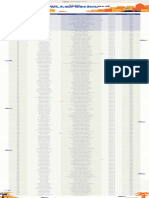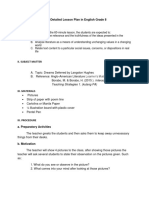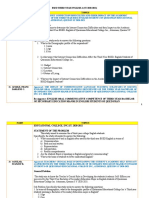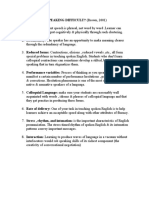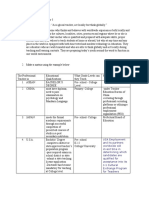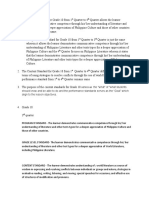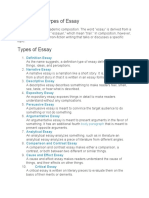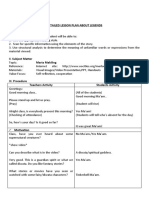Saint Vincent de Paul Diocesan College: Read and Explore
Saint Vincent de Paul Diocesan College: Read and Explore
Uploaded by
TrebligCondeCopyright:
Available Formats
Saint Vincent de Paul Diocesan College: Read and Explore
Saint Vincent de Paul Diocesan College: Read and Explore
Uploaded by
TrebligCondeOriginal Title
Copyright
Available Formats
Share this document
Did you find this document useful?
Is this content inappropriate?
Copyright:
Available Formats
Saint Vincent de Paul Diocesan College: Read and Explore
Saint Vincent de Paul Diocesan College: Read and Explore
Uploaded by
TrebligCondeCopyright:
Available Formats
Saint Vincent de Paul Diocesan College
Andres Soriano Avenue, Mangagoy, Bislig City
College Department – Teacher Education
Second Semester, Academic Year 2020-2021
LESSON 2: Stairway to News Writing:
Techniques and Principles
READ and EXPLORE
At the end of the lesson, you are expected to:
1. Identify various sources of news;
2. Determine potential sources of school news;
3. Record the ways in news gathering; and
4. Apply the news elements in specific situations.
READ and EXPLORE
Sources of News
One should bear in mind that facts are the main foundations of news articles. Hence, a writer or
a journalist must have a high sense of smelling ability to newsworthy issues. This special ability is
dubbed as "nose for news" in journalism parlance. To be able to do so, a journalist must know the
avenues where he can gather data for his news articles.
1. Beat. The beat is the stable assignment of the reporter. For instance in a school setting, the
chief editor or the adviser is identifying assignments for the writers. Jane, a news writer is
assigned to gather news from the student body. Jane's beat is the student council only; thus,
what she concentrates on is only issues about the student body.
Being confined to only one assignment, the reporter achieves a sense of time
management and a chance to get through all the perspectives of the news. This will also
diminish hodgepodge ideas of the writer, especially a student journalist.
2. Written and Printed Documents. A good journalist looking for newsworthy issues. One of
his/her sets of sources includes public documents --- either electronically or physically posted.
For example, if he she is gathering data for the newly imposed rules on wearing the prescribed
uniform, he/she may look into the minutes of the meeting or the resolution where such rules
are inscribed.
3. Observation. This may be done through a keen empirical observation. It exists as a writer
bears witness using the physical senses to what is happening in the local communities. In the
context of school paper, a writer must beware of the places and goings-on in the campus.
These may be activities that are not visible to the eyes of the many
4. Tips from Co-writers, Teachers and Students
5. Gantt Chart of Schedule or Calendar of Activities
6. Interviewing Key Informants. This is the gathering of information on a person-to-person
basis, straight from the experts or any resource person as a credible source.
GILBERT J. CONDE LESSON 2: STAIRWAY TO NEWS WRITING; TECHNIQUES AND
PRINCIPLES
1
Saint Vincent de Paul Diocesan College
Andres Soriano Avenue, Mangagoy, Bislig City
College Department – Teacher Education
Second Semester, Academic Year 2020-2021
More Sources of News
The internet has increased the available number of news sources. Audiences can go general
news sites covering broad topic areas.
1. Blogs. They represent another source of news, free from traditional economic, corporate,
political, or advertising considerations. There are blogs devoted to all sorts of topics. Blogs offer
alterative points of view to traditional media. Blogs provide an additional outlet for reporters to
explain why they reported a story in the way they did.
2. Citizen Journalism. In citizen journalism, ordinary citizens become amateur reporters. This
trend is facilitated by digital and cell phone video cameras and high speed Intemet access.
Traditional news media encourage citizen journalism, and many media outlets ask audience
members to submit photos and video clips. Citizen journalism is popular with the mainstream
news media in part because it is free content, but it also empowers the audience.
3. Hyperlocal News. This is a news referring to news coverage for a very small community. It
can be a single Zip Code or interest group in a defined geographic area Most hyperlocal news
appears on web sites. Publishers of hyperlocal news hope that the extremely local focus and the
coverage topics ignored by the traditional media will draw in people who generally de not
consume news. Twitter and Facebook have examples of hyperlocal new and visitors can find
news of interest to them and their close circle of friends.
Rules of Thumb in News Gathering
A writer must not only have the nose for news, but also consider the guidelines in
gathering data, Kamirez (2009) has published some of these rules of thumb in data gathering
for news waiting.
1. See for yourself. Nothing is more vivid when one sees the event right before his own
eyes. Becoming the first-hand witness, other than gathering through hershey, keeps the
spontaneity of ideas of the writer.
2. Find the person who knows. The writer should go directly to the person who is
considered as the key participant of the issue. Such a person may give the writer a sense of
confidence that what he/she will write is taken from the statements and ideas of the
persons, rather than surmising the ideas, effects and impacts of an issue. Further, this act
champions objectivity, thus diminishing bias.
3. Compare all versions. A writer must not rely solely on one version. As discussed in the
previous chapter, one should set myriads of perspectives, so as to limit the holes of biases.
Moreover, feel free to question inconsistencies and ensure the veracity of each statement or
information.
4. Be tactful and courteous, A writer is respectful of time. Hence, he should focus only on
the data needed. He should avoid spending the time of the interviewee on futile topics,
Courtesy is likewise seen in acts and words of the writer who gathers data. More often than
not, saying thank you is a good gesture to pay the interviewee the bother fee incurred.
5. Make and keep friends. Dependable informants are most valued assets, especially when
a writer is assigned in a single beat throughout the academic year When needed, give them
favorable mention in your stories. Never break the trust in the name of having a good scoop
of the news.
6. Print it. This rule of thumb reminds a writer or a journalist that unpublished wasted. The
fact that one has gathered data, the news is now considered a newsworthy item.
GILBERT J. CONDE LESSON 2: STAIRWAY TO NEWS WRITING; TECHNIQUES AND
PRINCIPLES
2
Saint Vincent de Paul Diocesan College
Andres Soriano Avenue, Mangagoy, Bislig City
College Department – Teacher Education
Second Semester, Academic Year 2020-2021
Handling Interview in News Gathering
The interview is the bedrock of information gathering in news writing. It is defined as the
process of “dyadic, relational communication, with a predetermined and serious purpose designed to
interchange behavior involving the asking and answering of questions (Soriano and Henson, 1995),
Sounds brain-cracking? Simply put, the interview is purpose-driven. Its main aim is to exchange ideas
through question style. Hence, the interviewer is the person who asks questions, while the interviewee
is the person who gives the answers.
Let us study the key points in such definition to bull's eye the meaning:
1. Dradic denotes that the interview is a person-to-person interaction between two parties.
2. Relational strongly suggests an interpersonal connection between the interview parties
3. Predetermined and serious papase mains that at least one of the two parties comes to the
interview with a goal and has planned the interview to focus on specific subject matter.
4. Interchanging behavior connotes sharing of expectations, roles, feelings and information.
5. Asking and answering questions taken as a single process) is crucial to the interviewing
process, questions serve as tools to obtain information
Stages in Interview
Here are some steps in conducting an interview using the formula known as the GOSS,
developed by Rue de Guilleland.
1. Know your Goal or purpose.
2. Present Obstacle encountered
3. Offer Solutions to these obstacles.
4. Start writing the interview story
Steps in Conducting the interview
1. Define the purpose
2. Conduct a background research of the topic you are assigned to
3. Set an interview appointment.
4. Make preliminary planning by listing down possible questions. There are six questions
beginning with five W's and one H. However, be sure to * specific who, another who, one more who
and final who. For instance. you are interviewing the principal of your school regarding the Brigada
Eskwela conducted fast May. You may ask as many WHO questions as you wish like.
i. Who was the proponent of the program?
ii. Who were the benefactors?
iii. Who were the participants?
iv. Who else tended the activity?
v. Who may be benefited by the program?
This technique should be practiced by a good data gatherer for a news article so that he/she may
accumulate basketfuls of data. In such a way, he/she may diminish subjectivity; subsequently, he/she
presents many perspectives as he/she can.
5. Meet the interviewee.
6. Get down to business. Ask the first question.
7. Establish early rapport, that is, from formal to less formal.
8. Tackle the more sensitive topic with respect and tactfulness.
9. Express some recovery statements.
10. Leave a thank you note.
GILBERT J. CONDE LESSON 2: STAIRWAY TO NEWS WRITING; TECHNIQUES AND
PRINCIPLES
3
Saint Vincent de Paul Diocesan College
Andres Soriano Avenue, Mangagoy, Bislig City
College Department – Teacher Education
Second Semester, Academic Year 2020-2021
Structure of News
Since this book is intended for novice writers and those who are skeptical yet whether or not to
join the publication, the structure of news discussed below is the basic news structure. For advanced
reporting, there are more types of news structure.
Newspaper articles are written using the inverted triangle format. Most journalism experts
agree to use triangle not pyramid. The inverted pyramid format is three dimensional that is referring to
special cases of developmental communication and interpretive journalism or investigative reportage.
Using the inverted triangle structure, a writer bears in mind that the most important information
is at the top (beginning of article) and the least important information is at the bottom (end of article).
With this format, the story or the news article will have the ability to undergo cutoff test (removing last
section(s) of story to quickly shorten story), without distorting its gist.
Reasons for the Inverted Triangle Structure
The inverted triangle is used in news writing because it makes reading easier and faster. It also
enables the hurried reader to get all the important facts in a very short period of time. Say, as he reads
the first three paragraphs, he knows already the gist of the news. It likewise satisfies curiosity in a
logical way, as it makes page makeup easier. Finally, it makes the work of the editor easier.
Let us try to compare the two stories.
Jack and Jill went up the hill to fetch a pail of
water.
-Versus-
Jack suffered a skull fracture and Jill is in
serious condition after the pair tumbled
down a hill during their ritual water-carrying
chores yesterday.
The second version tells a story packed with specific details. If you try to investigate the second
version gives ideas of WHO are involved in WHAT event, including the HOW and WHY it happened plus
the WHERE such incident happened and not to forget the WHEN it occurred. If you could spot the
details here, then you are getting the gist of the structure of the news, which follows a logical
presentation of details. Remember, too, that the structure of the news is based on logical importance.
GILBERT J. CONDE LESSON 2: STAIRWAY TO NEWS WRITING; TECHNIQUES AND
PRINCIPLES
4
Saint Vincent de Paul Diocesan College
Andres Soriano Avenue, Mangagoy, Bislig City
College Department – Teacher Education
Second Semester, Academic Year 2020-2021
ASSESS and REFLECT
TEST-I (TRUE - FALSE)
DIRECTIONS: On the space provided before each item, write TRUE if the statement is
factual and FALSE if it is erroneous.
__________ 1. Interviewing key persons gives the writer or the reporter an avenue to gather tertiary
information.
__________ 2. Written and electronic documents are good sources of primary data.
__________ 3. Citizen journalism is also a reliable news source.
__________ 4. Comparing version of stories is urged in news gathering because it diminishes the
existence of perspectives.
__________ 5. The news is structured following an inverted triangle style so that the least important
ideas and information will be highlighted.
__________ 6. Nose for news means that a writer must have a high sense to newsworthy events;
hence, stalking persons is permitted.
__________ 7. Bribing the sources of news in exchange to a scoop and mentioning them in your
stories are both unethical.
__________ 8. During the interview, impromptu questions are better suggested than written or
rehearsed questions.
__________ 9. Setting an interview appointment may be done via telephone.
__________ 10. Tackling sensitive topics during the interview is allowable as long as permission is
granted.
TEST-I (TRUE - FALSE)
DIRECTIONS: On the space provided before each item, write TRUE if the statement is
factual and FALSE if it is erroneous.
Look for five (5) news articles from different English newspapers and survey the articles
according to the matrix below:
Headline Writer Sources of News Names of Persons
Interviewed
-END of LESSON 2-
GILBERT J. CONDE LESSON 2: STAIRWAY TO NEWS WRITING; TECHNIQUES AND
PRINCIPLES
5
You might also like
- Butler Service ScriptDocument2 pagesButler Service ScriptTrebligConde84% (19)
- AGEC Leaderboard South AfricaDocument11 pagesAGEC Leaderboard South Africandlovupetu3No ratings yet
- Chapter 1-Quiz 2Document3 pagesChapter 1-Quiz 2Apenton Mimi56% (9)
- Lesson 1 Campus JournalismDocument6 pagesLesson 1 Campus Journalismmb Padilla0% (1)
- SIBALA - Lead Writing ExerciseDocument5 pagesSIBALA - Lead Writing ExerciseJulie-Ar Espiel SibalaNo ratings yet
- Thoughts From The Tao-Te Ching Rhetorical AnalysisDocument2 pagesThoughts From The Tao-Te Ching Rhetorical AnalysisJesus Alicea100% (2)
- Macro Skills ModuleDocument70 pagesMacro Skills ModuleJoefryQuanicoBarcebalNo ratings yet
- 1 - NOPSSCEA Operations ManualDocument33 pages1 - NOPSSCEA Operations ManualJohna Mae Dolar Etang50% (2)
- Chapter 4 - Reading MaterialDocument8 pagesChapter 4 - Reading MaterialPRINCESS JOY BUSTILLO100% (1)
- Saint Vincent de Paul Diocesan College: Read and ExploreDocument16 pagesSaint Vincent de Paul Diocesan College: Read and ExploreTrebligConde67% (3)
- Chapter 3 - Reading MaterialDocument11 pagesChapter 3 - Reading MaterialPRINCESS JOY BUSTILLONo ratings yet
- Lesson Plan in English 10Document2 pagesLesson Plan in English 10Angel MantalabaNo ratings yet
- Module 1 (Ele 140) Lesson 1: Linking Jounalism and The Campus PaperDocument35 pagesModule 1 (Ele 140) Lesson 1: Linking Jounalism and The Campus PaperScott Posey100% (1)
- CONTINUING RESISTANCE: CRITICISMS OF THE PHILIPPINE NATIONAL LANGUAGE POLICY by Rufus MontecalvoDocument12 pagesCONTINUING RESISTANCE: CRITICISMS OF THE PHILIPPINE NATIONAL LANGUAGE POLICY by Rufus MontecalvoRufus Casiño Montecalvo100% (2)
- MAJ 19 w2Document6 pagesMAJ 19 w2Clinton D. ZamoraNo ratings yet
- Poetry Semi Detailed Lesson PlanDocument2 pagesPoetry Semi Detailed Lesson PlanAlexis Dan Aquino MendozaNo ratings yet
- Overcoming Indifference 3Document4 pagesOvercoming Indifference 3RenzzyBautistaNo ratings yet
- The Campus Paper and Publication StaffDocument20 pagesThe Campus Paper and Publication StaffAllan VillelaNo ratings yet
- The Birth of High School PapersDocument8 pagesThe Birth of High School PapersEdison Dela Cruz Jr.100% (1)
- Poetry Lesson Plan For Demo TeachingDocument4 pagesPoetry Lesson Plan For Demo TeachingMaria Levie VergaraNo ratings yet
- Module 10 Eng 16Document3 pagesModule 10 Eng 16Divine CardejonNo ratings yet
- Synopsis of Afro-Asian LiteratureDocument57 pagesSynopsis of Afro-Asian Literatureمہنور مہتاب100% (2)
- The Food of ParadiseDocument18 pagesThe Food of ParadiseMitchel BibarNo ratings yet
- Chapter 7 - Reading MaterialDocument18 pagesChapter 7 - Reading MaterialPRINCESS JOY BUSTILLONo ratings yet
- Colegio de Dagupan School of Teacher EducationDocument46 pagesColegio de Dagupan School of Teacher EducationPRINCESS JOY BUSTILLONo ratings yet
- 1 Sop Final Bsed Eng Sy 2020 2021 Thesis Titles Rosemarie Castillo With Cla Comments 05.16.2021Document28 pages1 Sop Final Bsed Eng Sy 2020 2021 Thesis Titles Rosemarie Castillo With Cla Comments 05.16.2021Nicole R. IlaganNo ratings yet
- BSEE 40:: Campus JournalismDocument27 pagesBSEE 40:: Campus JournalismAnne Santos Castro100% (2)
- Analyzing Non-Linear Texts - Representing and Summarizing InformationDocument2 pagesAnalyzing Non-Linear Texts - Representing and Summarizing InformationJerum PalahangNo ratings yet
- Group Half A DayDocument1 pageGroup Half A DayBarrita Ritz Angelica100% (1)
- Pursue Lesson 2 - Module 2Document7 pagesPursue Lesson 2 - Module 2Cherry Rose J. DeniegaNo ratings yet
- Elements of Children and Adolescent LiteratureDocument13 pagesElements of Children and Adolescent LiteratureROANNE CASTRONo ratings yet
- Semi-Detailed Lesson Plan of Greek Mythology (The Beginning)Document3 pagesSemi-Detailed Lesson Plan of Greek Mythology (The Beginning)claudinepabnan86% (7)
- Semidetailedlessonplanop 121013230321 Phpapp02Document3 pagesSemidetailedlessonplanop 121013230321 Phpapp02Legrev AicragNo ratings yet
- Lesson Plan 19 The Keesh 10Document2 pagesLesson Plan 19 The Keesh 10Gwapong BataNo ratings yet
- Types of Purposeful ListeningDocument6 pagesTypes of Purposeful ListeningLouisiana SollestreNo ratings yet
- Unit 2Document14 pagesUnit 2George Kevin TomasNo ratings yet
- Semi-Detailed Lesson Plan in English 8 - Second Grading I. ObjectivesDocument2 pagesSemi-Detailed Lesson Plan in English 8 - Second Grading I. ObjectivesMar Sebastian67% (6)
- Characteristics of Chinese LiteratureDocument2 pagesCharacteristics of Chinese LiteratureUkulele PrincessNo ratings yet
- Correcting Sight Word Knowledge DeficitDocument23 pagesCorrecting Sight Word Knowledge DeficitCrispen Jay CoritanaNo ratings yet
- Campus Journ ActDocument3 pagesCampus Journ Actlyn calicdanNo ratings yet
- Lesson Plan - Communicative Competence IIIDocument2 pagesLesson Plan - Communicative Competence IIIIgnacio Jey BNo ratings yet
- ASSIGNMENT SocialLiteracyDocument1 pageASSIGNMENT SocialLiteracyTRISTAN JOY DEDUQUE FURAQUE100% (1)
- February 8 LP1Document3 pagesFebruary 8 LP1leroy gomezNo ratings yet
- Sociological Template 1 - Issues of Discourse 1Document5 pagesSociological Template 1 - Issues of Discourse 1CesarioVillaMartinLabajoJr.No ratings yet
- Final Examination in Eng121Document24 pagesFinal Examination in Eng121KAREN JANE BANAYATNo ratings yet
- Campus Journalism in The PhilippinesDocument1 pageCampus Journalism in The PhilippinesRussell Casiple100% (1)
- You Ask Me How Much I Love YouDocument2 pagesYou Ask Me How Much I Love Youdarwin100% (4)
- Topic: How A Selection May Be Influenced by Culture, History, Environment and Other FactorsDocument6 pagesTopic: How A Selection May Be Influenced by Culture, History, Environment and Other FactorsAleli Dueñas Antigo MarianoNo ratings yet
- What Makes Speaking DifficultDocument1 pageWhat Makes Speaking DifficultReikkaNo ratings yet
- The Period Before ChaucerDocument6 pagesThe Period Before ChaucerDonald Jhey Realingo Morada100% (1)
- Learning Activities For Chapter 5 AnsDocument3 pagesLearning Activities For Chapter 5 Ansrejesh100% (3)
- 5 Remedial Instruction in ListeningDocument11 pages5 Remedial Instruction in ListeningMs. Ludie MahinayNo ratings yet
- Daily Journal Practice TeachingDocument2 pagesDaily Journal Practice TeachingHARIBON INSIDERNo ratings yet
- G10 W8Document5 pagesG10 W8Roxanne PecenioNo ratings yet
- "Of Studies" by Francis BaconDocument18 pages"Of Studies" by Francis BaconRo AnnNo ratings yet
- The Morrow A Literary AnalysisDocument1 pageThe Morrow A Literary AnalysisBryan EcijaNo ratings yet
- Definition of Types of Essay Helping NotesDocument2 pagesDefinition of Types of Essay Helping NotesHassan MahmoodNo ratings yet
- There Is No Sure Formula For Organizing The Staff of The School PaperDocument2 pagesThere Is No Sure Formula For Organizing The Staff of The School PaperoranisouthNo ratings yet
- English Las8 q2 Week 3Document7 pagesEnglish Las8 q2 Week 3Vanessa C. MaghanoyNo ratings yet
- Photo EssayDocument2 pagesPhoto EssayMary Claire OndianoNo ratings yet
- Daily Lesson Plan (DLP in English)Document9 pagesDaily Lesson Plan (DLP in English)Alwin AsuncionNo ratings yet
- Teelit Date: Oct. 4-8, 2021 Detailed Lesson Plan About LegendsDocument2 pagesTeelit Date: Oct. 4-8, 2021 Detailed Lesson Plan About LegendsDiane AmadaNo ratings yet
- A Study Guide for Nadine Gordimer's "Once Upon a Time"From EverandA Study Guide for Nadine Gordimer's "Once Upon a Time"Rating: 5 out of 5 stars5/5 (1)
- English 22 Lesson 3Document8 pagesEnglish 22 Lesson 3TrebligConde100% (6)
- Encoding and Billing of ESC Grantees in The Higher Grade LevelsDocument5 pagesEncoding and Billing of ESC Grantees in The Higher Grade LevelsTrebligCondeNo ratings yet
- English 22 CoverDocument1 pageEnglish 22 CoverTrebligCondeNo ratings yet
- English 22 Lesson 3Document8 pagesEnglish 22 Lesson 3TrebligConde100% (6)
- English 22 Lesson 1Document11 pagesEnglish 22 Lesson 1TrebligCondeNo ratings yet
- Saint Vincent de Paul Diocesan CollegeDocument11 pagesSaint Vincent de Paul Diocesan CollegeTrebligCondeNo ratings yet
- Sociolinguistics 2020 MidtermDocument3 pagesSociolinguistics 2020 MidtermTrebligCondeNo ratings yet
- CLASS OBSERVATION SCHEDULE For TEACHERSDocument4 pagesCLASS OBSERVATION SCHEDULE For TEACHERSTrebligCondeNo ratings yet
- Judging SheetsDocument12 pagesJudging SheetsTrebligCondeNo ratings yet
- Applicant's FormDocument1 pageApplicant's FormTrebligCondeNo ratings yet
- Certificate of AppearanceDocument1 pageCertificate of AppearanceTrebligCondeNo ratings yet
- Learning Plan For English 8: Basic Education DepartmentDocument17 pagesLearning Plan For English 8: Basic Education DepartmentTrebligCondeNo ratings yet
- Table of Specification: Saint Vincent de Paul Diocesan CollegeDocument1 pageTable of Specification: Saint Vincent de Paul Diocesan CollegeTrebligCondeNo ratings yet
- Certification Assessment Instrument: RevisedDocument1 pageCertification Assessment Instrument: RevisedTrebligCondeNo ratings yet
- Analie Lesson PlanDocument1 pageAnalie Lesson PlanTrebligCondeNo ratings yet
- 1st Quarter Lesson 6 Exam WeekDocument2 pages1st Quarter Lesson 6 Exam WeekTrebligCondeNo ratings yet
- Saint Vincent de Paul Diocesan College: Instructional Learning Plan in English 8Document3 pagesSaint Vincent de Paul Diocesan College: Instructional Learning Plan in English 8TrebligCondeNo ratings yet
- Bucton KDocument5 pagesBucton KTrebligCondeNo ratings yet
- Instructional Learning PlanDocument3 pagesInstructional Learning PlanTrebligCondeNo ratings yet
- Table of Specification: Saint Vincent de Paul Diocesan CollegeDocument1 pageTable of Specification: Saint Vincent de Paul Diocesan CollegeTrebligCondeNo ratings yet
- Oral Defense Rating SheetDocument2 pagesOral Defense Rating SheetTrebligCondeNo ratings yet
- SUSI Student Application Form 2025Document5 pagesSUSI Student Application Form 2025Sudipto SarkerNo ratings yet
- Application For Privilege To Study at Reduced FeesDocument1 pageApplication For Privilege To Study at Reduced FeesAriel Dela CruzNo ratings yet
- SC List MBA Barch2020Document15 pagesSC List MBA Barch2020GIRADKAR ANKITNo ratings yet
- MSP RubricsDocument5 pagesMSP RubricsCharlie L. NadelaNo ratings yet
- Tengco, Nicole Ahn yDocument19 pagesTengco, Nicole Ahn ynicole tengcoNo ratings yet
- Report 3.4.3-2021-22 PDFDocument42 pagesReport 3.4.3-2021-22 PDFChris PresleyNo ratings yet
- Trustee Agenda 07-13Document177 pagesTrustee Agenda 07-13Aiv DeeNo ratings yet
- Statistics MADocument8 pagesStatistics MADecilyn Romero CatabonaNo ratings yet
- Cor UcpDocument1 pageCor UcpMary Gelene BarredoNo ratings yet
- Dixon LaurindaCVDocument14 pagesDixon LaurindaCVMirjana Monet JugovicNo ratings yet
- CV For LGU ApplicationDocument2 pagesCV For LGU ApplicationGherson EscobalNo ratings yet
- EC Meeting 1 JullyDocument83 pagesEC Meeting 1 Jullya.deal.a.day3No ratings yet
- Affidavit Financial SupportDocument2 pagesAffidavit Financial Supportioenga741No ratings yet
- Candidates Selected For An Erasmus Mundus Scholarship and Reserve Lists Planthealth Erasmus Mundus Joint Master Degree 5 Intake (2020 2022)Document3 pagesCandidates Selected For An Erasmus Mundus Scholarship and Reserve Lists Planthealth Erasmus Mundus Joint Master Degree 5 Intake (2020 2022)Mahendra paudel PaudelNo ratings yet
- Rutgers Fall 2023 INTL Timeline 2.23Document2 pagesRutgers Fall 2023 INTL Timeline 2.23velusunilNo ratings yet
- Visvesvaraya Technological UniversityDocument2 pagesVisvesvaraya Technological Universitysachinkulkarni13992No ratings yet
- Directed Writing Past PapersDocument7 pagesDirected Writing Past PapersBushraNo ratings yet
- RhomBus Eid Salami Exam LeaderboardDocument108 pagesRhomBus Eid Salami Exam LeaderboardjhanlieberttNo ratings yet
- FLJ - Made The Right ChoiceDocument1 pageFLJ - Made The Right ChoiceJon Arces CalicoyNo ratings yet
- Project Report IOPDocument9 pagesProject Report IOPShivali Chopra0% (1)
- Lembar PersembahanDocument1 pageLembar PersembahanAgoenk27No ratings yet
- 2024 Scholarship Applications Are OpenDocument1 page2024 Scholarship Applications Are OpenmortensenkNo ratings yet
- Mayoral Candidate Profile - Laurie Sears DeppaDocument1 pageMayoral Candidate Profile - Laurie Sears DeppaZainaAdamuNo ratings yet
- MOCES Guidelines 2010Document2 pagesMOCES Guidelines 2010Ryan A. RamirezNo ratings yet
- Education Resume - Kate Rathfon 6Document2 pagesEducation Resume - Kate Rathfon 6api-432453037No ratings yet
- Reflection PaperDocument2 pagesReflection PaperKatrina EscañoNo ratings yet
- University Gauhati: Online Application FormDocument1 pageUniversity Gauhati: Online Application FormSarfarazNo ratings yet
- Admission Schedule For Tha AY 21-22Document2 pagesAdmission Schedule For Tha AY 21-22Rajesh PinjarlaNo ratings yet

